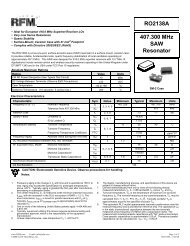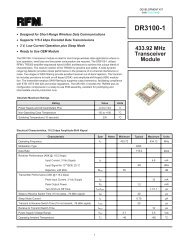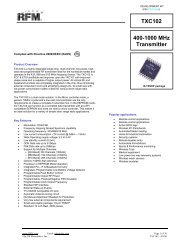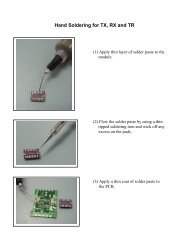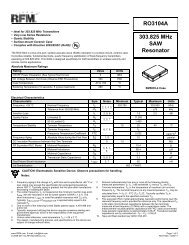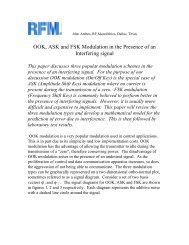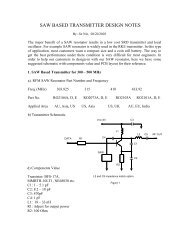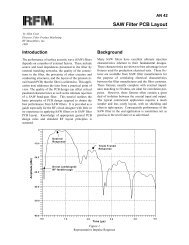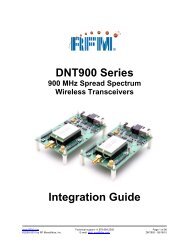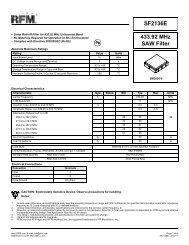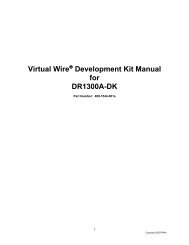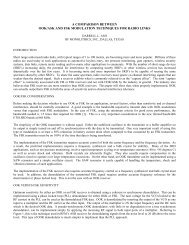TRC101 300-1000 MHz Transceiver - RF Monolithics, Inc.
TRC101 300-1000 MHz Transceiver - RF Monolithics, Inc.
TRC101 300-1000 MHz Transceiver - RF Monolithics, Inc.
You also want an ePaper? Increase the reach of your titles
YUMPU automatically turns print PDFs into web optimized ePapers that Google loves.
OOK/ASK SignalingThe RSSI may be used to recover an OOK/ASK signal using an external comparator, capacitivelycoupled to the RSSI output. Typically, Automatic Gain Control (AGC) is used to reduce the input signallevel upon saturation of the RSSI in the presence of strong or near-field ASK signals. The <strong>TRC101</strong> doesnot have an AGC option, however, the input LNA gain is programmable. The output RSSI signal levelmay be sampled upon enabling of the receiver to test if the signal level is in saturation. If saturation isconfirmed, the input LNA gain may be reduced until the RSSI output signal level falls within the RSSIdeviation range.Wake-Up ModeThe <strong>TRC101</strong> has an internal wake-up timer that has very low current consumption (1.5uA typical) andmay be programmed from 1ms to several days. A calibration is performed to the crystal at startup andevery 30 sec thereafter, even if in sleep mode. If the oscillator circuit is disabled the calibration circuit willturn it on briefly to perform a calibration to maintain accurate timing and return to sleep.The <strong>TRC101</strong> also incorporates other power saving modes aside from the wake-up timer. Return to activemode may be initiated from several external events:• Logic ‘0’ applied to nINT pin (16)• Low Supply Voltage Detect• FIFO Fill• SPI requestIf any of these wake-up events occur, including the wake-up timer, the <strong>TRC101</strong> generates an externalinterrupt on the nIRQ pin (5) which may be used as a wake-up signal to a host processor. The source ofthe interrupt may be read out from the Status Register over the SPI bus.Duty Cycle ModeThe duty cycle register may be used in conjunction with the wake-up timer to reduce the average currentconsumption of the receiver. The duty cycle register may be set up so that when the wake-up timerbrings the chip out of sleep mode the receiver is turned on for a short time to sample if a signal is presentand then goes back into sleep and the process starts over. See the Duty Cycle Set Register. Thereceiver must be disabled (RXEN bit 7 cleared in Power Management Register) and the wake-up timermust be enabled (WKUPEN bit 1 set in Power Management Register) for operation in this mode. Figure6 shows the timing for Duty Cycle Mode.Figure 6. Duty Cycle Mode TimingLow Battery DetectorThe integrated low battery detector monitors the voltage supply against a preprogrammed value andgenerates an interrupt when the supply voltage falls below the programmed value. The detector circuithas 50mV of hysteresis built in.SPI Interfacewww.<strong>RF</strong>M.com Email: info@rfm.com Page 11 of 42©by <strong>RF</strong> <strong>Monolithics</strong>, <strong>Inc</strong>. <strong>TRC101</strong> - 4/8/08



